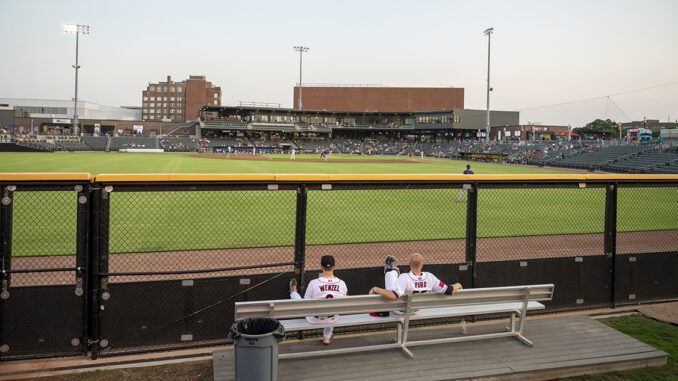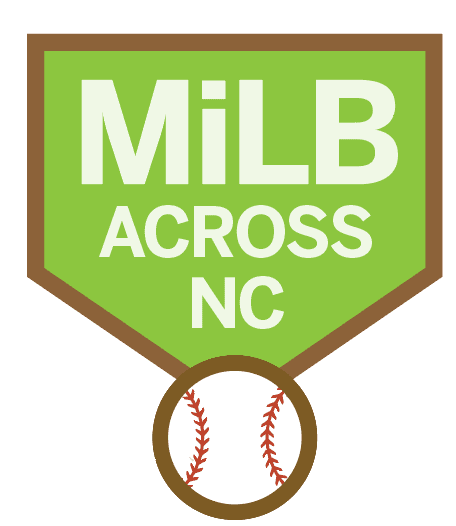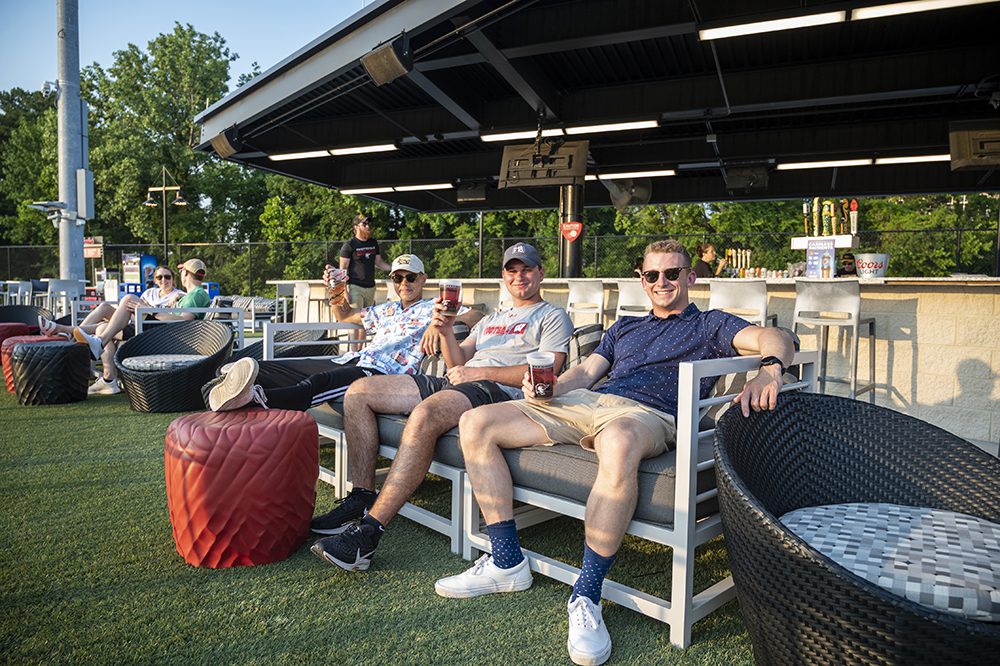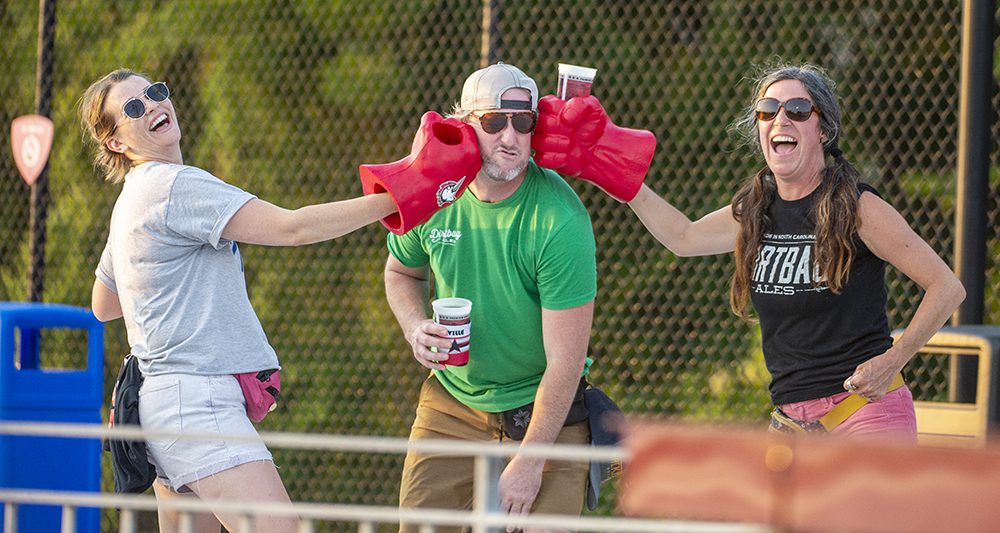
FAYETTEVILLE — On March 7, 1914, a raw rookie by the name of George Herman Ruth hit his first professional home run in Fayetteville while playing in a spring exhibition game for the then-minor league Baltimore Orioles.
 The blast was so prodigious and the young man that hit it so charismatic that fans congregated around the downtown Lafayette Hotel to get a glimpse of him and an autograph. They then followed him to the nearby train station to see him and his teammates off.
The blast was so prodigious and the young man that hit it so charismatic that fans congregated around the downtown Lafayette Hotel to get a glimpse of him and an autograph. They then followed him to the nearby train station to see him and his teammates off.
Years later, Ruth was purported to have said that he’d played in bigger places than Fayetteville “but darn few as exciting.”
The city’s excitement for baseball has waned over the past century since Ruth’s historic blast, with a series of minor league teams coming and going over the years. But with the arrival of the Fayetteville Woodpeckers in 2019, it’s finally starting to return.
“Fayetteville has truly embraced this team,” said local radio personality Jeff “Goldy” Goldberg during a break in his pregame broadcast from the right field picnic area last Wednesday. “And I think it will only continue to get better.”

The support can be seen in the numbers. The low Class-A Carolina League affiliate of the Houston Astros is averaging 3,110 fans per game through its first 27 home dates at the 4,786-seat Segra Stadium this season.
That’s a solid figure at face value, especially after the initial momentum the Woodpeckers built in their inaugural season of 2019 was stalled by the COVID pandemic. But it’s especially impressive given Fayetteville’s historic lack of support for its previous entries.
So why are the Woodpeckers succeeding where others have failed?
As any real estate agent will attest, the answer is simple: Location, location, location.
While the now-defunct Generals, Crocs and college summer wood bat league SwampDogs all played at J.P. Riddle Stadium — a glorified high school facility on the outskirts of town that didn’t come close to meeting minimum professional baseball standards — Fayetteville’s current team has a state-of-the-art park, more centrally located in the heart of a revitalized downtown, to call its home.
“This is definitely a destination,” said Kathy Gordon, a longtime Fayetteville baseball fan enjoying a game against the Kannapolis Cannon Ballers while wearing large red Woodpeckers “Hulk Hands” she called “an upgrade from the standard foam finger.”
“If this was Riddle Stadium, they wouldn’t get as big a crowd out here,” added Gordon’s co-worker Kevin Price. “Downtown is popping whenever there’s a game going on because you can get dinner, you can get drinks, you can walk pregame and after the game.”
The atmosphere inside the stadium during games can be just as electric, especially on weekends when the stands are packed.
There’s a kids’ play area in left field, rocking chairs in center, a picnic area with cornhole boards in right, covered seats around the infield, an air-conditioned club upstairs and concessions of every kind located around an ample concourse.
Among the most popular spots at Segra Stadium, however, is at Healy’s, the full-service bar located just beyond the right field wall.
There, fans can watch the action from traditional stadium seats, at high-top tables or, in the case of Gaines Cash and Jay Lopez — a pair of West Point cadets doing their summer training at nearby Fort Bragg — lounging comfortably on a couch.
“This is the best experience ever, sitting on a couch, drinking a beer and watching baseball,” said Cash, a native of Orlando, Florida, who came to the game with some friends because it was something to do. “How can you beat this? It’s pretty awesome, it’s a great atmosphere.”
That’s exactly what city planners and team officials had in mind when they finally brought to fruition a plan for a downtown ballpark that had been discussed, but never acted upon, for more than two decades.
“You don’t see a lot of stadiums like this at this level of the minor leagues,” said first-year Woodpeckers general manager Steve Pelle, who came to Fayetteville from the California League’s Inland Empire 66ers in San Bernardino, California. “It’s just a nice different touch. The brick makes it feel a little old but with a lot of new amenities.”
One of the unique aspects of Segra, which opened its doors in 2019 after the Woodpeckers spent two interim seasons at Campbell University in Buies Creek, is that it’s shoehorned between two railroad lines and is located directly next door to Fayetteville’s Amtrak station.

When the trains sound their horns as they pass, an occurrence that happens several times during games, a recording of a train horn is played over the PA system.
Pelle calls it part of the “ambiance” of a Woodpeckers game, although he admits that depending on the timing of the trains, they’re not always looked upon so agreeably.
“The trains give it that nice little flair,” he said. “But people don’t like them so much when they come by as they’re leaving and they get stuck in parking.”
While the new stadium and an aggressive staff that has maintained a high profile in the community have played a major role in helping turn Fayetteville back into a baseball town, perhaps the most important aspect of the team’s success is its ownership.
Unlike previous franchises, whose cash-strapped local owners eventually ran short on funds and were forced to operate on a shoestring, the Woodpeckers have no such worries because they are owned directly by the Astros.
With a 30-year lease that guarantees Segra will have a tenant at least through the 2049 season, Pelle said the team can concentrate its efforts on finding even better ways to enhance the fan experience and expand its reach in the community — especially the traditionally elusive Fort Bragg demographic.
It’s all part of an effort to ensure that despite its size, “darn few” places in the minor leagues — as The Babe might say — will be as exciting as Fayetteville.
Read NSJ’s 2022 MiLB Across NC features: Carolina Mudcats • Down East Wood Ducks • Winston-Salem Dash • Kannapolis Cannon Ballers • Greensboro Grasshoppers • Charlotte Knights • Durham Bulls • Hickory Crawdads • Asheville Tourists


